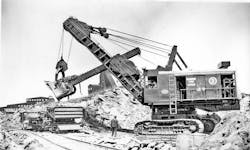Let's Rescue This 1930s Mining Shovel
Marion Steam Shovel introduced the 4160 4-yard mine and quarry loading shovel in 1927.
It was the first crawler mounted, fully revolving shovel designed specifically for this type of work; until this point, mining shovels were either fully revolving machines used solely for stripping, or partial swing rigs mounted on crawlers or temporary railroad tracks. It weighed 388,000 pounds, with a 34-foot standard boom and 21-foot, 6-inch dipper stick. Bad timing worked against its success, with only 27 built before discontinuance in 1936.
Two 4160s were delivered in 1930 to Hudson Bay Mining and Smelting (HBM&S) at its new open-pit copper mine in Saskatchewan, just across the border from Flin Flon, Manitoba. The shovels worked until the ore ran out, then were brought back to the surface. One 4160 is believed scrapped, but the other lives on today and is a candidate for recovery and preservation.
The surviving shovel’s next assignment was loading flux sand into rail cars at a nearby pit in Saskatchewan until circa 1973, when this pit was exhausted. It sat idle until around 1993, when the company quit claim to their land leases. Faced with the logistics and cost of removing the 194-ton shovel to its remaining property, HBM&S instead buried it in the sand pit, and there it remains today.
The shovel has been located from the crowd arms protruding slightly from its burial mound, and local interests are exploring and raising funds for its unearthing and preservation. Industrial preservation groups like the Historical Construction Equipment Association are also quite interested in this project, given the shovel’s rarity as likely the only surviving example of a machine that represents such an important technological advance.
The Historical Construction Equipment Association (HCEA) is a 501(c)3 non-profit organization dedicated to preserving the history of the construction, dredging and surface mining equipment industries. With over 3,800 members in 25 countries, our activities include publication of a quarterly educational magazine, Equipment Echoes, from which this article is adapted; operation of National Construction Equipment Museum and archives in Bowling Green, Ohio; and hosting an annual working exhibition of restored construction equipment. Our next International Convention and Old Equipment Exhibition will be September 16-18, 2022, at the National Construction Equipment Museum, 16623 Liberty Hi Road, Bowling Green, Ohio. Individual annual memberships are $35 within the U.S. We seek to develop relationships in the equipment manufacturing industry, and we offer a college scholarship for engineering and construction management students. Information is available at www.hcea.net, or by calling 419.352.5616, or emailing [email protected].
